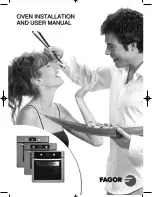
18
Microwaving principles
Microwaves are present in the atmosphere all
the time, both naturally and from manmade
sources. Manmade sources include radar,
radio, television, telecommunication links and
mobile phones.
Oven cavity
Base of
the oven
Stirrer motor
Waveguide
Microwave
stirrer
Magnetron
In a microwave oven, electricity is converted
into microwaves by the Magnetron. For
bottom feeding, please refer to page 29.
Reflection
The microwaves bounce off the metal walls
and the metal door screen.
Transmission
Then they pass through the cooking
containers to be absorbed by the
water molecules in the food, all foods
contain water to a more or lesser extent.
Important note
The dish used to cook or reheat the
food will get warm during cooking,
as the heat conducts from the food.
Even in microwaving, oven gloves
are required! Microwaves can not
pass through metal and therefore
metal cooking utensils can never
be used in a microwave, for
cooking on microwave only.
How microwaves cook food
The microwaves cause the water molecules
to vibrate which causes friction
, i.e.
heat.
This heat then cooks the food.
Microwaves are also attracted to fat and
sugar particles, and foods high in these will
cook more quickly. Microwaves can only
penetrate to a depth of 4-5 cm and as heat
spreads through the food by conduction, just
as in a traditional oven, the food cooks from
the outside inwards.
Foods not suitable for cooking by
microwave only
Yorkshire pudding and souffles. This is
because these foods rely on dry external
heat to cook correctly, do not attempt to
cook by microwave.
Foods that require deep fat frying cannot be
cooked either.
Standing time
When a microwave oven is switched off, the
food will continue to cook by conduction –
not by microwave energy. Hence standing
time
is very important in microwaving,
particularly for dense foods i.e. meat, cakes
and reheated meals (refer to page 20).
Boiled eggs
Do not boil eggs in your microwave.
Raw eggs boiled in their shells can
explode and cause serious injury.
















































